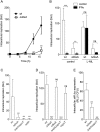Guanosine tetraphosphate relieves the negative regulation of Salmonella pathogenicity island-2 gene transcription exerted by the AT-rich ssrA discriminator region
- PMID: 29930310
- PMCID: PMC6013443
- DOI: 10.1038/s41598-018-27780-9
Guanosine tetraphosphate relieves the negative regulation of Salmonella pathogenicity island-2 gene transcription exerted by the AT-rich ssrA discriminator region
Abstract
The repressive activity of ancestral histone-like proteins helps integrate transcription of foreign genes with discrepant AT content into existing regulatory networks. Our investigations indicate that the AT-rich discriminator region located between the -10 promoter element and the transcription start site of the regulatory gene ssrA plays a distinct role in the balanced expression of the Salmonella pathogenicity island-2 (SPI2) type III secretion system. The RNA polymerase-binding protein DksA activates the ssrAB regulon post-transcriptionally, whereas the alarmone guanosine tetraphosphate (ppGpp) relieves the negative regulation imposed by the AT-rich ssrA discriminator region. An increase in the GC-content of the ssrA discriminator region enhances ssrAB transcription and SsrB translation, thus activating the expression of downstream SPI2 genes. A Salmonella strain expressing a GC-rich ssrA discriminator region is attenuated in mice and grows poorly intracellularly. The combined actions of ppGpp and DksA on SPI2 expression enable Salmonella to grow intracellularly, and cause disease in a murine model of infection. Collectively, these findings indicate that (p)ppGpp relieves the negative regulation associated with the AT-rich discriminator region in the promoter of the horizontally-acquired ssrA gene, whereas DksA activates ssrB gene expression post-transcriptionally. The combined effects of (p)ppGpp and DksA on the ssrAB locus facilitate a balanced SPI2 virulence gene transcription that is essential for Salmonella pathogenesis.
Conflict of interest statement
The authors declare no competing interests.
Figures





References
Publication types
MeSH terms
Substances
Grants and funding
LinkOut - more resources
Full Text Sources
Other Literature Sources
Research Materials
Miscellaneous

